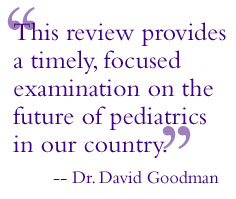|
|
For Release: July 5, 2005
Contact: Andy Nordhoff (603) 650-1492
New Pediatrician Workforce Policy Addresses Growing Challenges in Health Care
HANOVER, NH - A report from the Committee on Pediatric Workforce, authored by David Goodman, M.D. of Dartmouth Medical School, has resulted in a revised policy statement from the American Academy of Pediatrics (AAP), challenging current assumptions about the need for greater numbers of doctors and raising concerns about a continued lack of racial diversity and geographic distribution in the pediatric workforce. The report and new policy statement appear in the July 5 issue of the journal Pediatrics.
"This review provides a timely, focused examination on the future of pediatrics in our country," said Dr. Goodman, who is a professor of pediatrics and of community and family medicine at Dartmouth Medical School, and a pediatrician at Dartmouth-Hitchcock Medical Center. "We saw the need to accompany the new AAP policy statement with a comprehensive report that presents background information and examines emerging trends to reflect our unchanging goal to provide effective healthcare to children." He noted that although the health of elderly populations is the subject of much current media focus, children constitute a quarter of the U.S population and consume an increasing portion of health care services.
In the report, "The Pediatrician Workforce: Current Status and Future Prospects," Goodman and the Committee on Pediatric Workforce describe important recent changes in the pediatrician workforce, which include:
- New majority status of female pediatricians, a historic first for any medical specialty in the U.S.;
- Positive growth in medical students choosing careers in pediatrics, leading to an 18% increase in pediatricians per child in the last decade;
- Increased reliance on international medical graduates, with approximately one third of practicing pediatricians attending medical school outside the U.S. and Canada;
- Limited improvement in the ethnic and racially diversity of pediatricians that is not keeping pace with an increasingly diverse population of U.S. children;
- High geographic variation among pediatricians, leaving some rural and inner-city populations underserved, while other regions have a very high supply.
Addressing what the report calls "fundamental changes that will have important effects on the professional lives of pediatricians and children's health care delivery," the AAP's new policy proposes incentives to enhance the geographic distribution of pediatricians, but does not advocate an increase in the number of medical school graduates or pediatric residency positions.
"Regional disparities represent the most significant challenges to pediatric care and the answer does not lie in adding more pediatricians to the population," said Goodman, a member of the Center for Evaluative Clinical Sciences (www.dartmouth.edu/~cecs/) at Dartmouth Medical School, a consortium of physicians dedicated to improving the quality and value of clinical care. "Supply is not a critical factor in terms of how well healthcare systems take care of patients and how well those patients do in terms of health and well-being."

The new AAP policy guidelines also include strategies to recruit a larger percentage of culturally and racially diverse pediatricians to accommodate the increasing population of minority children. "We really face a crisis of diversity in pediatrics," notes Goodman. "This country is changing very quickly and the cultural roots of providers do make a difference in terms of patient care in a number of ways. If the aim is to improve the health and well-being of patients then it is desirable to have as diverse a workforce as possible."
The Committee on Pediatric Workforce manages issues pertaining to the supply, requirements, demographics, and geographic distribution of general and subspecialty pediatricians. It evaluates major policy and regulatory issues that shape the pediatric workforce, such as the funding of graduate medical education, international medical graduates, the geographic distribution of pediatricians, and changing systems of health care delivery. The COPW formulates the Academy's positions and responses to legislation, federal and regulatory bodies, and other organizations on physician workforce issues.
Download a pdf of the report, "The Pediatrician Workforce: Current Status and Future Prospects" from Pediatrics.
-DMS-
